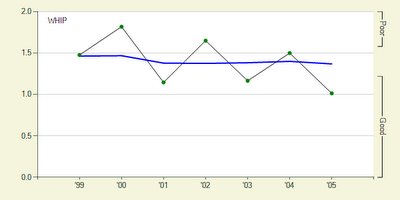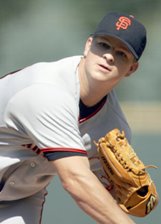Bronx Banter
Canyon of Heroes
Count the Rings
Crosstown Rivals
Futility Infielder
High and Tight
I'm No Idiot
LoHud Yankees blog
No Maas
No Sense Worrying
NYY News
Pending Pinstripes
Pinstripe Alley
Pinstriped Blog
Pride of the Yankees
River Ave Blues
RLYB
Sporting Brews
Sports World NY
Unbiased Yankee Fan
Was Watching
Weblog That Derek Built
Yankees Baseball Blog
Yankees Prospects
Yanks Blog
Yanks Fan vs. Sox Fan
Farnsworth is terribly inconsistent year to year, having put up solid seasons in 2001, 2003 and 2005, while stinking it up 2000, 2002 and 2004. Pictures are worth a thousand words, so here's his stats, graphically: (all graphs from fangraphs.com - dark blue lines represent league averages)




Looking at his career stats, nothing really jumps out at you regarding what may be the cause of the inconsistency. His GB/FB ratio and percentage of inherited runners scoring fluctuates like the rest of the stats. I thought maybe he was having trouble getting ahead of hitters, but he's thrown first pitch strikes to roughly 49% of the batters he's faced over his career (which is surprisingly good, the great Mariano has dealt first pitch strikes to roughly 51% of the hitters he's faced in his career), so that discounts that theory. I gave up looking at stats that were solely a function of Farnsworth's pitching, and decided to look beyond the traditional stats and see what kind of situations he was used in. In doing so, I came to a conclusion: Kyle Farnsworth is a glorified long reliever.
Let me explain. Using David Pinto's Day by Day Pitching Database, I sorted Farnsworth's career into two categories, games he's pitched 1 inning or less, and those were he's thrown more than 1 inning. I neglected to include his rookie year of 1999, because he was primarily a starter that year. The results were startling:
| Games | IP | Hits | Kper9 | BBper9 | K/BB | ERA | BAA | WHIP | |
|---|---|---|---|---|---|---|---|---|---|
| 1 IP or less | 297 | 243.0 | 226 | 11.07 | 5.11 | 2.17 | 4.89 | .310 | 1.50 |
| more than 1 IP | 53 | 82.2 | 59 | 9.80 | 2.72 | 3.60 | 2.83 | .240 | 1.02 |
It's a tale of 2 pitchers; one who seemingly throws gas on the fire, and another who has Hall of Fame worthy numbers. While the long relief Farnsworth doesn't strike out as many batters, he gives up less hits, less walks and less runs - a trade anyone would make. Fifty-three games and 82.2 IP is a sufficient sample size to say this is more than just a fluke.
Why was he more effective in longer roles? Who knows. Maybe he was throwing great that day and his manager decided to leave him longer than he usually would. Maybe he came into less pressure situations and was able to relax. Maybe he wasn't throwing well for 2 weeks beforehand, and he had a chip on his shoulder when his manager used him in middle relief instead of in set-up situations. It leaves you in quite the quandary, but I'm leaning toward believing he was brought in for multiple innings with less on the line, allowing him to chill out a bit.
Now I'm not suggesting Joe Torre should use Farnsworth for multi-inning appearances with nothing on the line, the man is going to be paid very well for the next 3 years to deal with the pressure and slam the door. I'm trying to dig deeper into the enigma that is Kyle Farnsworth, but his stats are over the place with almost no trend lasting longer than 2 years, making it almost impossible to figure out what's going on. He's developed a reliance on the book "Mind Gym" in the last year, so we can all hope that'll cure his inconsistency and allow him to be as effective in 2006 as he was in 2005.
Aaron Gleeman
Amazin' Avenue
Athletics Nation
AZ Snakepit
Ballpark View
Balls, Sticks & Stuff
Baltimore Chop
Baseball Analysts
Baseball Crank
Baseball, Etc.
Baseball Musings
Beyond the Box Score
Bleed Cubbie Blue
Bless You Boys
Bluebird Banter
Brew Crew Ball
Bucs Dugout
Buster Olney's ESPN blog
Camden Chat
Cardinals Diaspora
ChiSox Daily
Crawfish Boxes
Cub Reporter
DA Humber : Baseball Central
Daily Lancer
Detroit Tigers Weblog
Dodger Thoughts
Doug's Business of Baseball
DRays Bay
Ducksnorts
Eddie Kranepool Society
Elephants in Oakland
Faith & Fear in Flushing
Federal Baseball
Fire Brand of the AL
First Inning
Fishstripes
Gaslamp Ball
Good Phight
Halo's Haven
Honest Wagner
Independent Thinking
Inside the Dodgers
Inside the White Sox
Jayson Stark's ESPN blog
Joy of Sox
Let's Go Tribe
Lookout Landing
Lone Star Ball
Major League Blog
McCovey Chronicles
Mets Blog
Mike's Baseball Rants
Minor League Ball
Only Baseball Matters
Orange and Black Baseball
Over The Monster
Peter Gammon's ESPN blog
Phillies Nation
Purple Row
Redleg Nation
Red Reporter
Rival Fish
Royals Authority
Royals Corner
Royals Review
South Side Sox
Talking Chop
Transaction Guy
Twinkie Town
USS Mariner
Viva El Birdos
The Template is generated via PsycHo and is Licensed.









